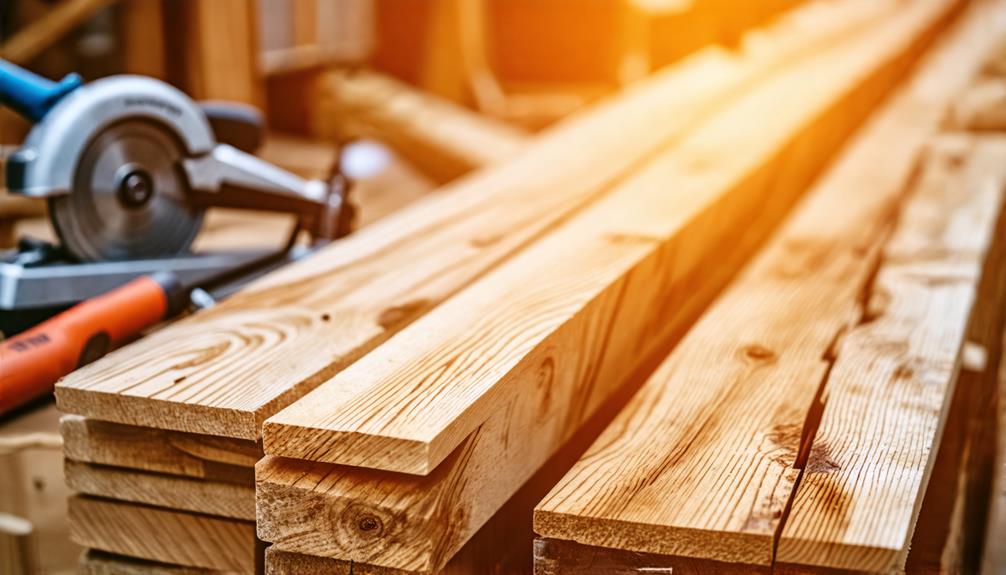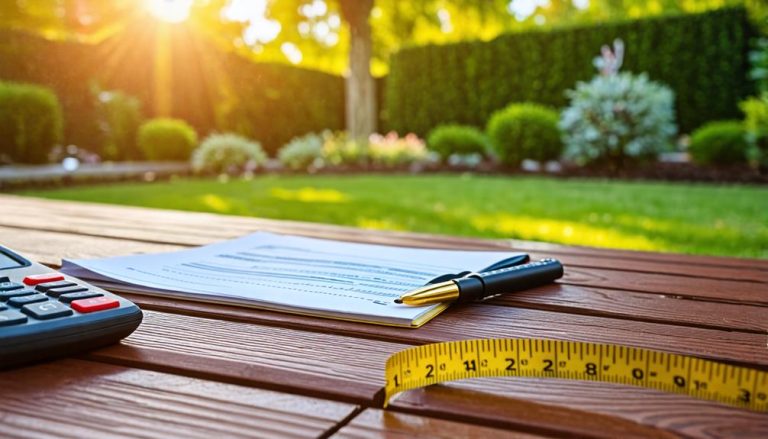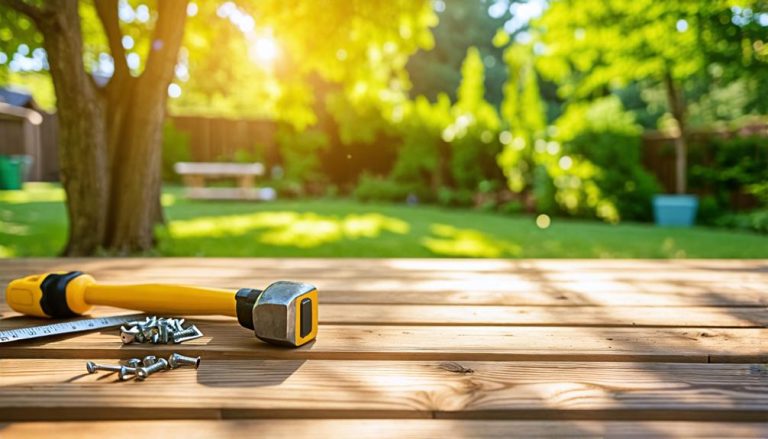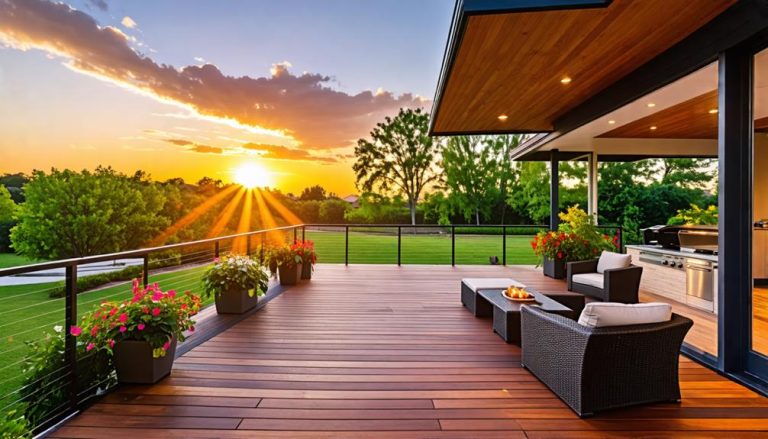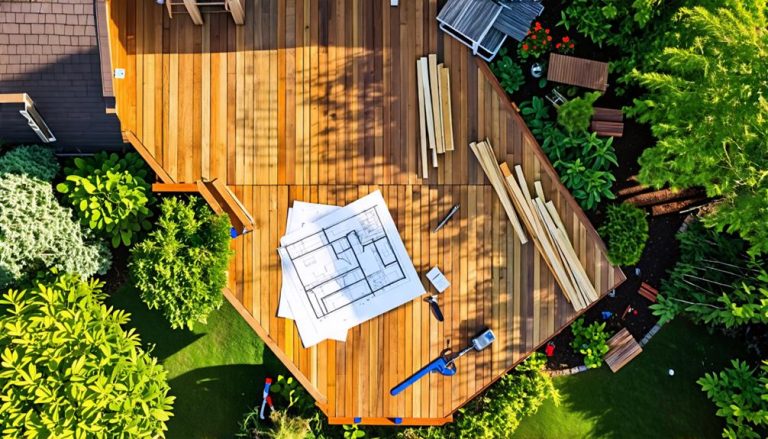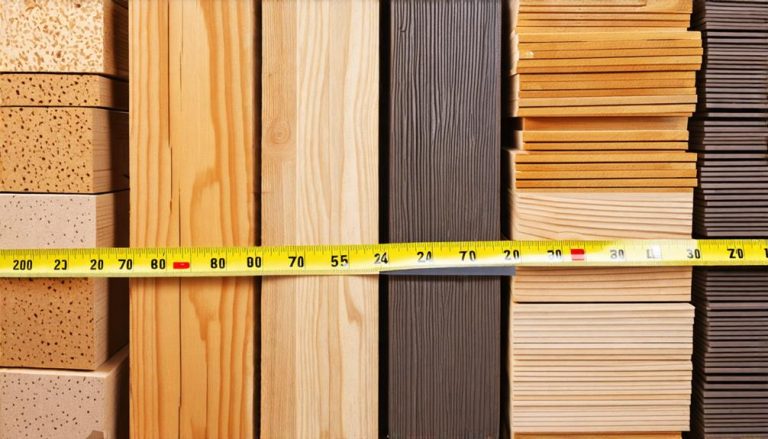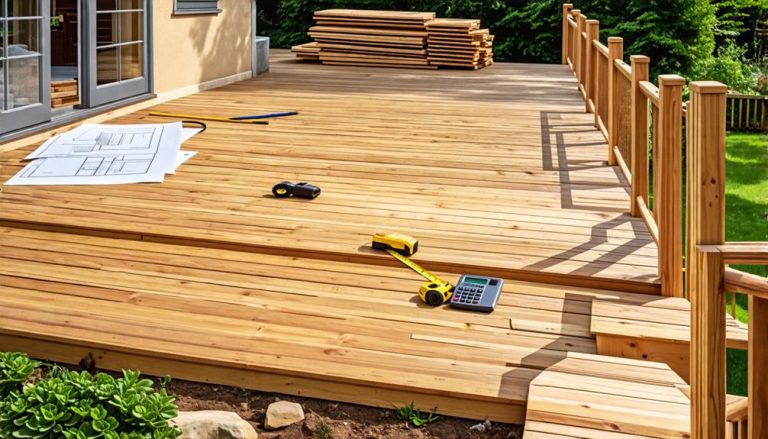What Is the Cheapest Way to Build a Deck Right Now?
The cheapest way to build a deck right now is by using pressure-treated lumber and performing the installation yourself. You’ll save dramatically on material costs, as pressure-treated wood offers durability and resistance to decay at an affordable price. By tackling the project DIY-style, you can eliminate labor expenses, which often account for up to 50% of the total cost. Opt for standard-sized boards and 2×6 planks for decking to maximize cost-effectiveness. Research local building codes and deck-building techniques to guarantee structural integrity and safety. Consider renting specialized tools instead of purchasing them outright. With proper planning and execution, you can create a long-lasting, value-adding outdoor living space while keeping expenses in check.
Pressure-Treated Lumber Deck Construction
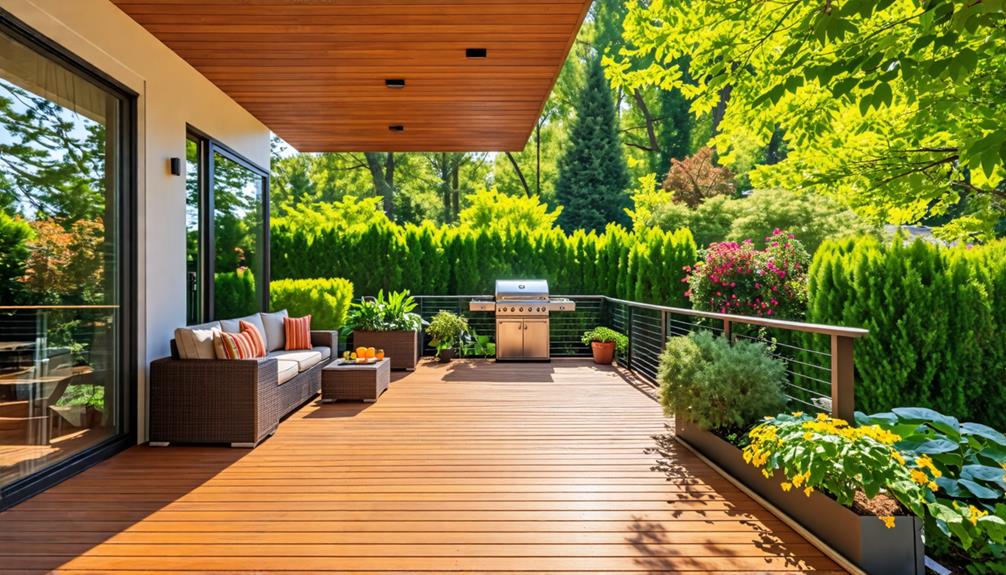
When it comes to building an affordable deck, pressure-treated lumber stands out as a cost-effective material choice that offers long-term durability benefits. This type of construction is part of our residential construction services at Dream Decks, where we emphasize quality, cost control, and adherence to schedule.
You’ll find significant savings by opting for DIY installation, as the straightforward nature of working with pressure-treated wood makes it accessible for many homeowners with basic carpentry skills. By choosing this material and approach, you’re not only reducing initial costs but also investing in a deck that will withstand the elements for years to come, potentially saving you money on repairs and replacements in the future.
Cost-Effective Material Choice
At the heart of building an affordable deck lies the choice of materials. When considering cost-effective options, pressure-treated lumber emerges as the clear frontrunner. This versatile wood product, infused with preservative chemicals, offers exceptional durability and resistance to decay, insects, and moisture at a fraction of the cost of alternative materials.
You’ll find that pressure-treated lumber comes in various grades and sizes, allowing you to tailor your deck design to your specific needs and budget. How can you maximize your savings? Opt for standard-sized boards, which are typically more affordable than custom dimensions. Additionally, consider using 2×6 boards for decking instead of wider planks, as they’re often more economical.
When selecting pressure-treated lumber, pay attention to the retention level, which indicates the amount of preservative used. For ground-contact applications, choose a higher retention level to guarantee longevity. While pressure-treated lumber requires periodic maintenance, such as cleaning and sealing, its initial low cost and long lifespan make it an excellent choice for budget-conscious homeowners. By carefully planning your deck layout and minimizing waste, you can further reduce material costs without compromising on quality or structural integrity.
DIY Installation Savings
One of the most significant ways to save money on your pressure-treated lumber deck is through DIY installation. By taking on the project yourself, you’ll eliminate labor costs, which can account for up to 50% of the total expense. However, before embarking on this endeavor, it’s crucial to assess your skill level and the complexity of your deck design. Do you have the necessary tools and expertise to handle the construction?
To maximize your DIY savings, start by thoroughly researching deck-building techniques and local building codes. You’ll need to obtain the proper permits and ensure your design meets safety standards. Consider renting specialized tools, such as a post-hole digger or circular saw, rather than purchasing them outright. When laying out your deck, use string lines and batter boards for precise measurements.
How will you handle the foundation? Concrete footings are essential for stability, so take care to dive into the task of digging them to the correct depth and width. As you build, pay close attention to joist spacing, fastener selection, and proper flashing installation. Remember, while DIY can save money, it’s imperative to prioritize safety and structural integrity throughout the process.
Long-Term Durability Benefits
Despite the initial cost, opting for pressure-treated lumber in your deck construction offers substantial long-term durability benefits. This chemical treatment process enhances the wood’s resistance to rot, decay, and insect infestation, greatly extending the lifespan of your deck. When properly maintained, a pressure-treated deck can last up to 30 years, providing excellent value for your investment.
Consider these key advantages of pressure-treated lumber:
- Weather resistance: The treatment helps the wood withstand harsh environmental conditions, including rain, snow, and UV rays.
- Structural integrity: Pressure-treated lumber maintains its strength and stability over time, reducing the risk of warping or splitting.
- Low maintenance requirements: Compared to untreated wood, pressure-treated lumber requires less frequent staining, sealing, or replacement.
While the upfront cost may be higher than untreated alternatives, you’ll save money in the long run by avoiding frequent repairs and replacements. Additionally, pressure-treated lumber’s durability guarantees that your deck remains safe and structurally sound for years to come. Have you considered the potential cost savings and peace of mind that come with choosing pressure-treated lumber for your deck project? By investing in this durable material, you’re not only building a deck but also creating a lasting outdoor living space for your home.
Benefits
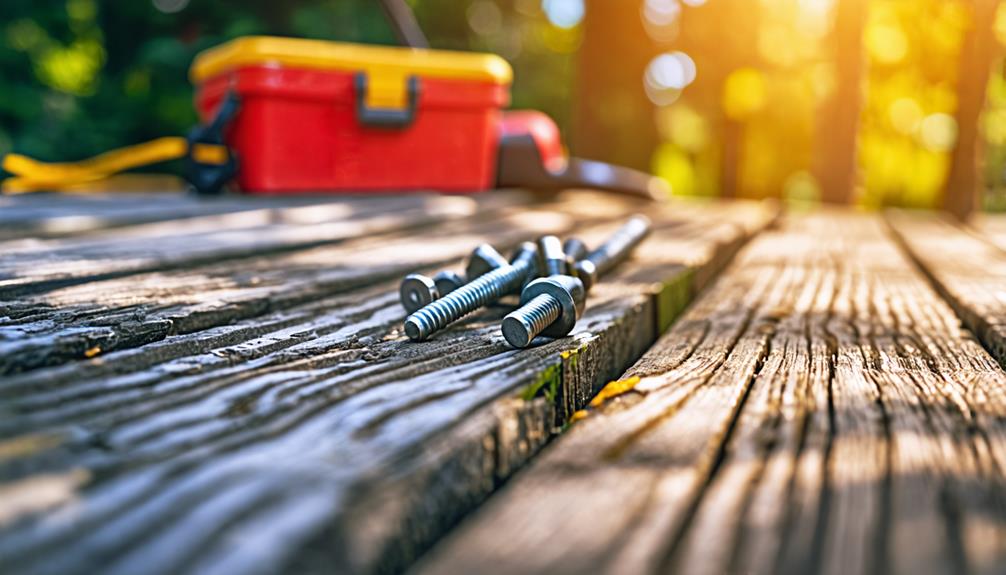
Building a deck offers numerous benefits that can enhance your home and lifestyle. With a custom-designed deck, you can seamlessly integrate your personal style into your home’s architecture, extending your living space outdoors. You’ll create a cost-effective outdoor living space that not only increases your property’s value but also focuses on custom solutions and attention to detail.
This deck, tailored to your aesthetic preferences and functional needs, provides a versatile area for entertaining guests or simply relaxing. This low-maintenance addition to your home allows you to enjoy the outdoors without the hassle of constant upkeep, making it an attractive option for homeowners seeking to maximize their living space and investment.
Cost-Effective Outdoor Living Space
Many homeowners find that a cost-effective outdoor living space can dramatically increase their enjoyment of their property. A well-designed deck offers an affordable solution to expand your living area and create a versatile space for relaxation, entertainment, and outdoor activities.
By choosing economical materials and employing smart design strategies, you’ll be able to construct a deck that enhances your home’s value without breaking the bank.
To maximize the benefits of your cost-effective deck:
- Opt for pressure-treated lumber, which offers durability and affordability.
- Design a simple, rectangular shape to minimize material waste and labor costs.
- Consider a ground-level deck to avoid expensive railings and stairs.
When planning your deck, focus on functionality and practicality. How will you use the space? What features are essential for your lifestyle? By prioritizing these aspects, you’ll create a deck that meets your needs without unnecessary expenses.
Additionally, consider the long-term maintenance costs of different materials. While some options may have a higher upfront cost, they could save you money in the long run through reduced upkeep requirements. Remember, a cost-effective deck doesn’t mean sacrificing quality or style; it’s about making informed choices that balance affordability with functionality and aesthetics.
Increased Home Value
Beyond enhancing your outdoor living experience, a cost-effective deck can appreciably boost your home’s value. When you’re considering selling your property, a well-constructed deck can serve as a significant selling point, potentially increasing your home’s market value by up to 75% of the deck’s cost. This return on investment makes building a deck an attractive option for homeowners looking to improve their property’s appeal and worth.
You’ll find that a deck’s value-adding potential varies based on several factors. The size, materials used, and overall design quality play indispensable roles in determining how much value it adds. Have you considered how your deck will complement your home’s existing architecture? A thoughtfully designed deck that seamlessly integrates with your house’s style can have a more substantial impact on its value. Furthermore, the geographical location of your property influences the deck’s perceived value. In regions with mild climates where outdoor living is prioritized, a deck might yield an even higher return on investment. Remember, while building the cheapest deck possible can save money upfront, investing in quality materials and craftsmanship will likely result in a higher long-term value increase for your home.
Versatile Entertainment Area
A well-designed deck transforms your outdoor space into a versatile entertainment area, offering countless opportunities for socializing and relaxation. You’ll find that a deck can serve multiple purposes, adapting to various events and activities throughout the year. Whether you’re hosting a summer barbecue, enjoying a quiet evening with family, or simply lounging in the sun, your deck becomes an extension of your living space.
To maximize your deck’s potential as an entertainment hub, consider these key features:
- Built-in seating: Incorporate benches or ledges along the perimeter to accommodate more guests comfortably.
- Multi-level design: Create distinct zones for dining, lounging, and cooking by varying the deck’s height.
- Lighting options: Install ambient and task lighting to extend usability into the evening hours.
Have you considered how a deck can enhance your home’s functionality? By adding this versatile outdoor area, you’re not only increasing your living space but also creating a focal point for gatherings. The deck’s design should complement your home’s architecture and landscape, ensuring a seamless shift between indoor and outdoor environments. With proper planning and execution, even a budget-friendly deck can become the heart of your outdoor entertainment setup.
Low-Maintenance Relaxation Spot
In addition to serving as an entertainment hub, a deck offers the perfect low-maintenance relaxation spot for homeowners. You’ll find that a well-designed deck can become your personal oasis, requiring minimal upkeep while providing maximum enjoyment. Have you considered how a deck can transform your daily routine?
When choosing materials for your low-maintenance deck, opt for composite decking or pressure-treated lumber. These options resist weathering, rot, and insect damage, greatly reducing the need for regular maintenance. How often will you need to clean or treat your deck? With these materials, a simple annual cleaning with soap and water is typically sufficient.
To further enhance your relaxation space, incorporate built-in seating or planter boxes. These features not only add functionality but also reduce the need for additional furniture. Consider installing a pergola or shade sail to create a comfortable retreat from the sun. Have you thought about adding outdoor lighting? LED deck lights can extend your enjoyment into the evening hours while consuming minimal energy. By thoughtfully designing your deck with low-maintenance features, you’ll create a serene outdoor living space that allows you to unwind without the worry of constant upkeep.
Cost-Effective Fastening Options
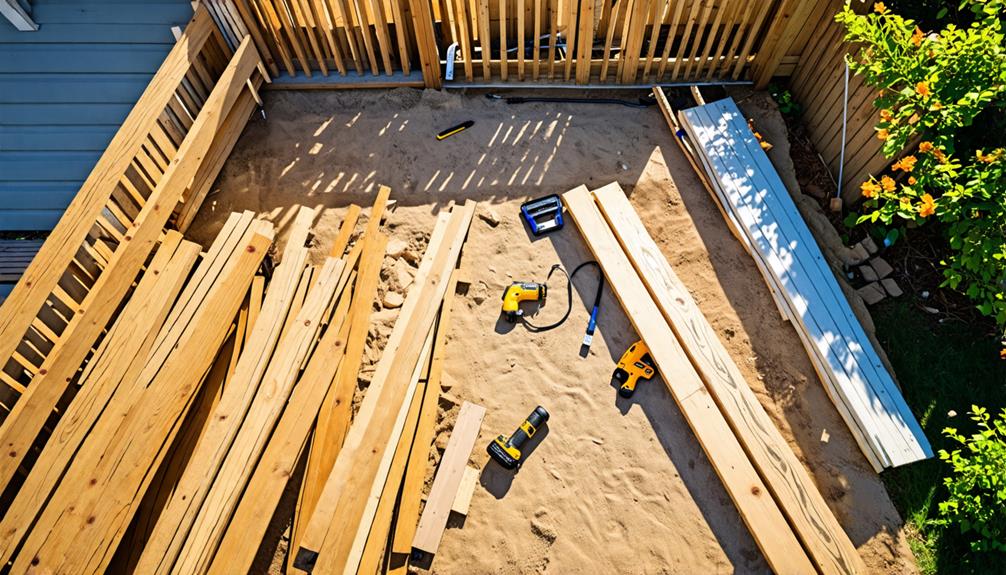
When building a deck on a budget, you’ll want to carefully consider your fastening options. You can choose between traditional methods like nails and screws, or explore more modern alternatives such as hidden fastener systems and adhesives. To help you make an informed decision, let’s compare these options regarding cost, durability, and ease of installation:
| Fastener Type | Cost | Durability | Ease of Installation | Aesthetic Appeal |
|---|---|---|---|---|
| Nails | Low | Moderate | High | Low |
| Screws | Medium | High | Medium | Medium |
| Hidden Fasteners | High | High | Low | High |
| Adhesives | Low | Varies | Medium | High |
Nails Vs Screws Comparison
Choosing between nails and screws for your deck’s construction isn’t just about personal preference; it’s a decision that can greatly impact your budget. Nails are typically less expensive than screws, making them an attractive option for cost-conscious builders. However, screws offer superior holding power and are less likely to pop out over time, potentially saving you money on future repairs.
When comparing nails and screws, consider these factors:
- Installation speed: Nails can be driven faster, especially with a pneumatic nailer, reducing labor costs.
- Removal ease: Screws are easier to remove if you need to replace boards, which can be beneficial for long-term maintenance.
- Weather resistance: Screws, particularly coated ones, tend to resist corrosion better than nails, extending the life of your deck.
The choice between nails and screws also depends on your local building codes and the specific areas of your deck. For example, you might use nails for the main decking boards but opt for screws in high-stress areas like railings or stairs. Ultimately, the most cost-effective approach may involve a combination of both fasteners, strategically used to balance initial costs with long-term durability and maintenance considerations.
Hidden Fastener Systems
Hidden fastener systems offer a sleek, professional look for your deck while potentially saving you money in the long run. These systems use specialized clips or brackets that attach to the sides or grooves of deck boards, creating a smooth surface free from visible screw heads. While the initial cost may be higher than traditional fasteners, hidden systems can reduce long-term maintenance expenses and extend your deck’s lifespan.
When considering hidden fasteners, you’ll encounter several options. Clip systems, which fit between boards and screw into the joists, are popular for their ease of installation. Alternatively, biscuit joiners utilize small, crescent-shaped fasteners that fit into pre-cut slots in the deck boards. For a more budget-friendly approach, you might explore edge-mount systems that attach to the sides of boards.
How do you choose the right system for your project? Consider factors such as your decking material, climate conditions, and budget constraints. Some systems work better with specific types of wood or composite decking, while others offer superior resistance to moisture and temperature fluctuations. Have you factored in the potential labor savings? Many hidden fastener systems can considerably reduce installation time, offsetting their higher upfront cost.
Cost-Effective Adhesive Options
While hidden fastener systems offer a sleek look, they’re not the only cost-effective option for securing your deck boards. Adhesives can provide a strong, long-lasting bond without the need for visible screws or nails.
When contemplating adhesive options for your deck construction, you’ll want to focus on products specifically designed for exterior use and compatible with your chosen decking material.
Polyurethane construction adhesive: Offers excellent water resistance and flexibility
Epoxy-based adhesives: Provide superior strength and durability for heavy-duty applications
Silicone-based adhesives: Ideal for areas with high moisture exposure
When selecting an adhesive, you’ll need to consider factors such as drying time, temperature resistance, and ease of application. How will the adhesive perform in your local climate? Does it require special tools or preparation? Remember that while adhesives can be cost-effective, they may require more skill and precision during installation.
You’ll also want to guarantee proper surface preparation and follow manufacturer guidelines for maximum results. By carefully weighing your options and reflecting on long-term performance, you can choose the most suitable adhesive for your deck project.
Frequently Asked Questions
How Long Does a Pressure-Treated Lumber Deck Typically Last?
You can expect your pressure-treated lumber deck to last 15-20 years with proper maintenance. It’s resistant to rot and insects, but you’ll need to clean, seal, and repair it regularly to maximize its lifespan. Annual inspections are essential.
Are There Eco-Friendly Alternatives to Pressure-Treated Lumber for Deck Construction?
You’ve got eco-friendly options for your deck! Consider composite decking, reclaimed wood, or naturally rot-resistant woods like cedar or redwood. Bamboo’s another sustainable choice. These alternatives can be pricier but offer durability and environmental benefits.
What Maintenance Is Required for a Pressure-Treated Lumber Deck?
You’ll need to clean your pressure-treated deck annually with soap and water. Apply a water-repellent sealer every 2-3 years. Inspect for loose boards, protruding nails, and signs of rot. Replace damaged parts promptly to maintain safety and appearance.
Can I Build a Deck Myself, or Should I Hire a Professional?
You can build a deck yourself if you’re handy and have the time. However, if you’re inexperienced or tackling a complex project, it’s wise to hire a professional. They’ll guarantee proper construction and code compliance.
Are There Any Safety Concerns With Pressure-Treated Lumber Decks?
You should be aware of potential safety concerns with pressure-treated lumber decks. While they’re generally safe, you’ll want to take precautions when handling the wood, avoid burning it, and seal it regularly to prevent chemical leaching.

